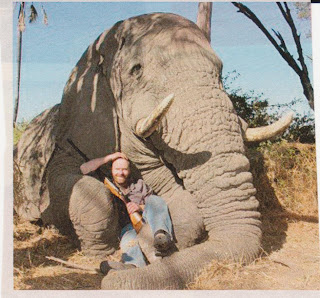The Thrill of the Kill
Pictures evoke responses and stories. When you look at this picture, what stories spring to mind about the trophy hunter, the hunt, the elephant, the owner of the reserve, other animals, gun lobbyists, environmental activists ….?
What beliefs and
feelings come to the fore?
I wondered if the
tusks would be sold, if the feet would be used as stools or ashtrays, the ears
as floor mats, the tail as a wall-hanging. Is the photo a sort of medal
celebrating ‘the kill’? Does the act itself satisfy some sort of blood-lust, an
addictive testosterone-driven dominance and aggression, a need to prove
‘manhood’? I wondered about the one-sided ‘contest’, the hollow ‘victory’,
about the land-owner’s role in things, about the hunter’s pose and self-satisfied
smile.1 Or is it amusement?
I felt repulsion,
disgust, sadness.
“Animals in a social group have relationships with
each other…….. One African herd always travelled slowly because one of its
members had never fully recovered from a broken leg suffered as a calf” and “…baby
African elephants who have seen their families killed by poachers, and
witnessed tusks being cut off bodies: these young animals wake up screaming in
the night”. “’If I learned anything from my time among the elephants’ writes the
scientist Douglas Chadwick:
It is the extent to which we are kin. The warmth of
their families makes me feel warm. Their capacity for delight gives me joy.
Their ability to learn and understand things is a continuing revelation for me.
If a person can’t see these qualities when looking at elephants, it can only be
because he or she doesn’t want to’”2
Elephants are
critically endangered/endangered in a number of countries and vulnerable in
Africa.3 Yet in response
to this post I expect specious, spurious, fallacious arguments and protests
from hunters.
1. McCallum, Ian Ecological Intelligence: rediscovering ourselves in nature Africa
Geographic 2005
2. Masson, Jeffrey Moussaiff & McCarthy, Susan When Elephants Weep: the emotional lives of
animals
Delta Book by Dell Publishing NY 1995


I believe that elephants are like humans. They love and care for each other and mourn when a family member dies just like we do. I would like to go back to the elephant sanctuary in Knysna where you can really see the kindness in these animals and witness how kind they can be to humans. They are loving and accepting. I think these "killers" see the elephants as only "part objects" as they would say in psychology. That way they can get the thrill from the kill without recognizing it as a living being. There is no way you could kill an elephant if you recognize it as a "whole object" or "being" with a soul, heart, and family.
ReplyDeleteMaybe it's denial, de-sensitizing, rationalising in order to justify their actions?
ReplyDeleteBut chickens have soul, heart and family and we eat them... do we draw a line somewhere - size? intelligence? scarcity? domestication?
ReplyDeleteNow that's food for thought Alison! I need to look at my own consumption patterns, asking 'in what ways do I indirectly contribute to animal suffering'?
ReplyDeleteAnd in some instances hunting and fishing for food may be justified. I'm not so sure about managed culling.
But poaching and trophy hunting do stand out as crimes against animals in my book
Came across this today - posted by Care 2 Action:
ReplyDeleteIndian officials are using endangered elephants to demolish shacks built by illegal immigrants in Assam's forest land. Dr. R.D. Tanwar, India's Chief Conservator for Forests, explains that the region's hilly terrain makes it impossible for bulldozers to enter, hence the use of elephants.
Demolishing buildings requires ramming into concrete and iron, which could cause injury, pain and mental distress to elephants. This is in clear violation of Section 11 of India's Prevention of Cruelty to Animals Act.
Using elephants as bulldozers is a disgrace to one of India's most treasured national species. Please urge Dr. R.D. Tanwar to end the practice and find cruelty-free alternatives to demolishing shacks!
Poachers in south-west Chad have killed at least 86 elephants including 33 pregnant females in less than a week, in a potentially devastating blow to one of central Africa's last remaining elephant populations.
ReplyDeleteGroups of elephants follow traditional migration routes during the dry season from Central African Republic, through Chad to Cameroon. Thirty years ago there were estimates of 150,000 animals across the region, but today that figure could be as low as 2,000.
According to the International Fund for Animal Welfare (IFAW), the elephants were killed near Fianga, close to the border between Chad and Cameroon, and their tusks
were hacked off.
http://thegreentimes.co.za/stories/species-protection/item/1950-86-elephants-killed-in-chad-poaching-massacre?utm_source=Green+Times+Subscribers&utm_campaign=7f6f04ff9f-Issue+90&utm_medium=email